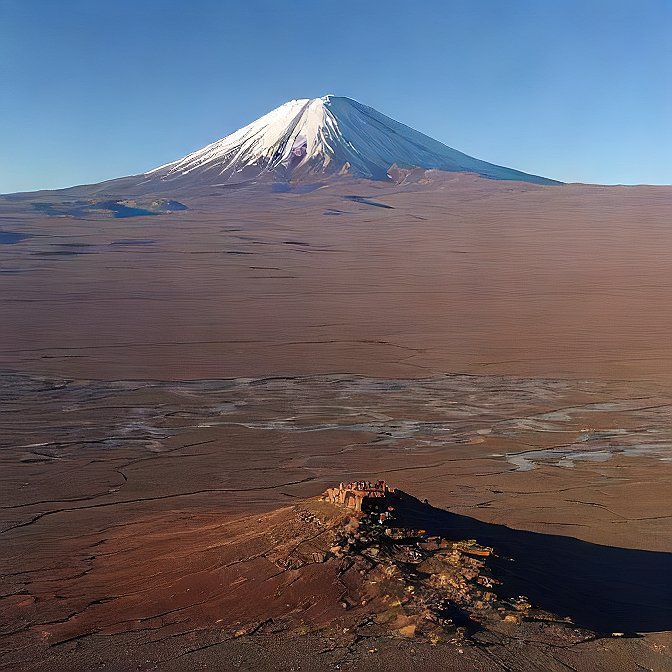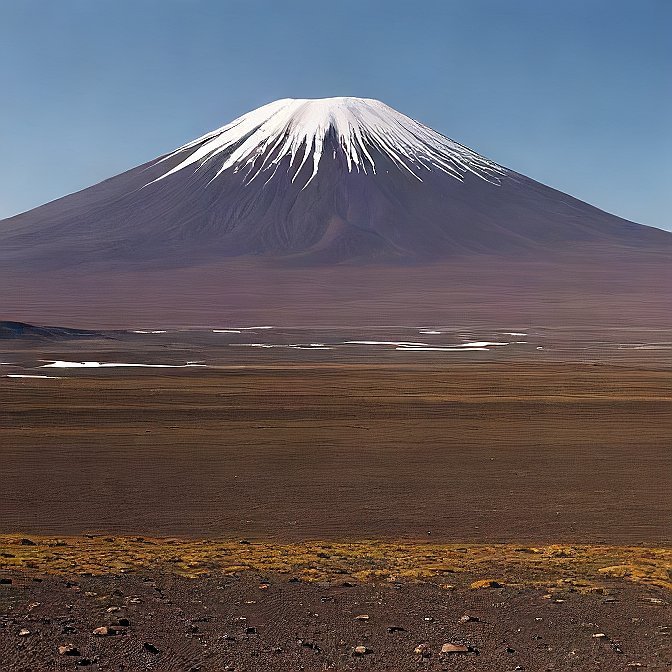Table of Contents
Introduction

Mount Llullaillaco rises like a regal volcano between Argentina and Chile within the Andes Mountains to provide spelunkers and historical tourism enthusiasts with their perfect exploration destination. Ancient history has bestowed upon this dramatic peak both scientific and cultural distinctions, which highlight its status as a prominent geological masterpiece and one of the most vital excavation sites. This impressive site meets the needs of veterans as well as cultural investigators and seekers of distinctive journeys through its remarkable collection of attributes.
What Makes Mount Llullaillaco Unique?
Mount Llullaillaco defies comparisons as an active volcano based on its 6,739-meter elevation that positions it as the globe’s third highest. This volcanic peak elevates above the Atacama desert to become a well-known mountain reference point throughout the entire South American mountain structure. From its narrow peak that reaches into the sky above the Atacama Desert, the volcano produces an impressive vista.
Mount Llullaillaco stands out among other volcanoes because it possesses distinctive, beautiful natural features while holding critical archaeological significance. The indigenous peoples view Mount Llullaillaco as sacred, and the Incas listed it as an essential religious spot. Before European expeditions to Llullaillaco, the local people declared this site spiritually significant by using it for their crucial sacred practices.
The world-class archaeological find of ancient Inca mummies stands out most at Mount Llullaillaco among all exploration sites. During 1999 scientists discovered three mummified bodies inside the volcanic peak. Experts believe that these preserved mummified bodies represent Inca sacrifices which have delivered essential knowledge about the spiritual culture of the ancient society. Because of these archaeological discoveries Mount Llullaillaco has gained status as both a trekking hotspot and research site for the ancient Inca Empire.
Getting to Mount Llullaillaco
The geographical detachment from major transportation routes increases the travel difficulty for people visiting Mount Llullaillaco. Tourists who wish to explore the volcano must start from Salta in Argentina. The mountain base of this location can be reached by two methods: using rented cars or joining guided tours. Travelers must use specially equipped vehicles to access the mountain base since the roads there are in poor condition.
The summer months in the Southern Hemisphere that cover November to March should be the preferred travel period for an expedition to Mount Llullaillaco. June through October stands out as the ideal period for hiking because the environmental conditions are most conducive. Visitors need to understand how dangerous trekking conditions are at the mountain owing to its elevation and harsh climate, even though summer months offer beneficial conditions.
At the beginning of your journey, you will cross through the Atacama Desert, which holds the distinction as the driest portion of land worldwide. The alien environment consists of empty salt fields as well as towering mountain peaks, which establish powerful foreground-background interrelationships. Your journey to Mount Llullaillaco’s base acquires value with each step you take because the remarkable natural sights will constantly absorb your sight.
Hiking and Exploring Mount Llullaillaco
The main purpose that brings people to Mount Llullaillaco is its volcanic terrain, which they want to climb. Every adventurer must show exceptional physical readiness to reach Mount Llullaillaco’s summit. Hikers who venture into this mountain site need superior physical ability combined with essential weather knowledge because harsh conditions and height changes alongside mountain slopes make climbing extremely difficult. The dangerous condition of altitude sickness occurs when mountain hikers elevate too fast, so they need to perform low-altitude acclimation before starting their trek.

Different levels of hiking trails lead to the summit of Pico del Obispo. The main base camp that serves as the starting point for this expedition settles at 16,400 feet elevation near 5,000 meters altitude. The planned path for hikers goes from unstable rock formations towards volcanic fields until it reaches the summit. The challenging pass crossing enables viewers to observe breathtaking views of both Andes mountains and desert landscapes.
During the hike, hikers experience changing natural habitats that gradually shift from small plant life to alpine vegetation while ascending through altitudes. The arid desert area stands in opposition to the volcanic rock formations, so you experience both a feeling of solitude and an adventurous spirit. Your feeling of accomplishment reaches its peak when you near the summit to witness remarkable extended views from the arid desert that spans across the border into Chile.
The Llullaillaco Archaeological Site: An Ancient Mystery
Mount Llullaillaco surpasses most trekking sites because of its rich archaeological value. Archaeological research conducted by Dr. Johan Reinhard in 1999 revealed the mummified three Inca individuals at the summit. A ritualistic context surrounded these mummies when archaeologists found them together with pottery artifacts, textile remains, and mineral gold objects. The mummies preserved for over 500 years represent among the most exceptional examples of Inca traditions of sacrifice.
The mummies found in this site have enabled historians and archaeologists to discover extensive details about Inca civilization together with their religious traditions. The mummies received their death by sacrificial offerings which served ceremonial purposes for the gods. The Inca Empire conducted sacred religious ceremonies at Mount Llullaillaco summit by sacrificing offerings to Inti namely the sun god.
Visitors who discover the archaeological site of Mount Llullaillaco gain historical connections that most other travel destinations cannot match. All of the mummies are preserved inside the High Altitude Archaeological Museum of Salta yet the discovery location maintains its status as a symbol of historical and cultural importance. The summit’s remains of ancient civilization create for visitors a powerful connection to the region’s advanced seclusive spiritual and cultural background.
Curious for more? Dive into our other exciting blogs!
The Surrounding Nature and Ecosystem
There is both archaeological value and an exotic natural environment on Mount Llullaillaco. The high-altitude setting features diversified natural species that have successfully adapted to survive under extreme conditions. The native Andes camelids, including the vicuña and llama, inhabit the area because the high-altitude vegetation provides adequate grazing opportunities. Eagles, together with condors, fly above the volcanic terrain while the land contains odd rock formations and salt flats.
The mountaintop attracts nature enthusiasts who consider it their ultimate paradise. Through its salt flats and canyons and volcanic plains the Atacama Desert generates perfect photographic conditions for nature photographers. The setting transforms completely through different hours but the sunrise and sunset reveal their most beautiful state. The mountain’s slopes receive distorting shadows from shifting daylight while exposed to the extensive desert region.
Nighttime sky conditions in this area deliver pristine viewing of stars because of rugged desert conditions. Struggling against scant light pollution allows stars in this area to shine at levels superior to worldwide averages thus giving serious astronomers an exceptional chance to study celestial wonders.
Mount Llullaillaco: Adventure Beyond the Hike

The completion of the Mount Llullaillaco hike leads most visitors to other attractions throughout the surrounding area. Many tourists journey to Salta to admire both its colonial buildings and its functioning market activities representing the main historical and cultural elements of the town. The visitors who depart from Salta follow Quebrada de Humahuaca to see its colorful mountains alongside extensive canyons and now have World Heritage status.
Scientists conducting investigations find scientific attractions in both geology and volcanology at the Mount Llullaillaco region. Travelers must conduct thorough examinations of multiple volcanoes that are located in the volcanic region.
The experience of visiting Mount Llullaillaco provides visitors with a connection to pure spirituality in addition to its natural wonders and physical challenges. Throughout many centuries, indigenous peoples maintained their shrine at this mountain to worship their divine forces. Visitors to the peak can experience personal introspection while thinking about local historical and cultural traditions, which deepens the meaning of their travel.
Conclusion
Tourists from all types of backgrounds have numerous experiences to find at Mount Llullaillaco. Tourists seeking adventure together with history students, along with nature lovers, will discover a unique, unforgettable journey to explore this historic volcano. Mount Llullaillaco allows people to encounter the adventure of summit climbing while showcasing amazing archaeological finds on its peak, where adventure and cultural heritage converge.
Mount Llullaillaco stands as an essential travel destination because of its picturesque environment, historical importance, and spiritual aura, which appeal to all visitors who want to feel the essence of the Andes. Interested individuals seeking adventure through natural grandeur and ancient relics alongside deep land affiliations should select Mount Llullaillaco as their future travel destination.
For more info about volcanoes: Click Here.
FAQs
What is the best time to hike Mount Llullaillaco?
Visitors should plan their Mount Llullaillaco expedition during the Southern Hemisphere summer, which falls between November and March. Mountain Llullaillaco presents its best trekking conditions for visitors within the summer months of the Southern Hemisphere. Every visitor ascending the mountain should monitor changing weather since the summit often gets covered by snow and frost.
Are there any safety precautions I should take while hiking Mount Llullaillaco?
Hiking at high altitudes such as mountains needs proper planning for success. Meticulous acclimatization at a reduced altitude must be done as the first step before beginning your mountain hike because it lessens the risk of altitude sickness. One needs suitable outdoor equipment that consists of apparel suited to the cold temperatures alongside waterproof boots as well as protective items from the sun. A local guide should be hired because they provide safety measures and improve the overall visit.
Can I visit the archaeological site of Llullaillaco without a guide?
The summit can be accessed independently yet using a guide remains the recommended choice. The archaeological worth of the location together with safety guidance becomes accessible through guide services while you explore the demanding surface. The guide can teach you about both the cultural and historic value of this location.





